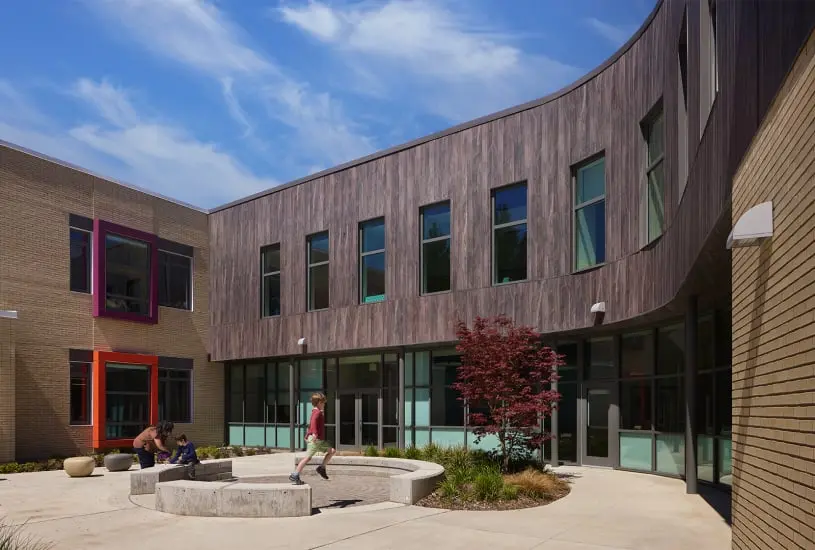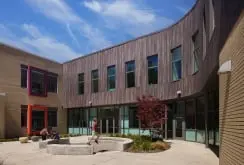 | 1.5 LU / HSW |
 | 1.5 LU / HSW |
Room: F150-151
Furnished by: Smith System + Steelcase Learning
Audience: Facilities Personnel

Call to Action: Our Call to Action is that every participant will come away better informed about, and with research to argue for, increased funding for school modernization in the face of persistently declining investment in school facilities.
Abstract: School districts that spend tax dollars to improve their schools can get much more than a new or renovated building. A new study has demonstrated statistically significant connections between school modernization and occupants’ well-being and satisfaction; and that the modernization process enhances community engagement and connectivity. Evidence also indicated that school modernization has a significant positive impact on key educational indicators, including test scores, graduation rates, and enrollment over time. Conducted by Perkins Eastman in conjunction with the Drexel University School of Education, the “Addressing a Multi-Billion Dollar Challenge” study evaluated more than two dozen schools—both modernized and non-modernized—across the District of Columbia and Baltimore City school districts. With tools to measure indoor environmental quality, assessments of design, layout, and “ambiance” of each building’s interior and exterior, questionnaires for the people who use the schools, and interviews with community members, the research team concluded that modernized schools outperformed non-modernized schools to the significant benefit of students, teachers, and staff in almost every category. The multi-disciplinary research team for this study investigated the differences between 28 modernized and non-modernized elementary, middle, and high schools. Students showed enhanced academic performance in the updated schools. Modernized schools also hold the potential to enhance community health and wellness while helping to anchor their communities through, among other things, providing health clinics, food distribution, and publicly accessible recreational facilities. This study was performed against a backdrop of shocking disinvestment in the US public schools that educate more than 49.4 million children across the country, according to the National Center for Education Statistics. A public school’s average age is 42 years, according to the US Department of Education, and according to a 2021 report called The State of our Schools, the annual shortfall in maintenance and improvements for those buildings is $85 billion. Identifying the potential benefits of school modernization that will help jurisdictions build a stronger case for the importance and funding of school modernization was the goal of this study. The study also provides recommendations for how best to spend modernization dollars, as well as tools and guidance for designers and school districts who might want to replicate the study’s methods.
Learning Objectives:

Sean leads Perkins Eastman’s international K-12 education practice. Understanding how intrinsic learning is to the human experience, he sees schools as the center of community bringing together civic architecture, sustainable design, and innovative educational planning to create high-performing, inspiring places where students learn and grow. A global thought leader in education facilities research and design, he is co-director of the Consortium for Design and Education Outcomes, a partnership with Drexel University’s School of Education.

Bruce is a Clinical Professor at Drexel University’s School of Education, where he serves as the Director of the Educational Policy program, and the M.S. degree in Education Improvement and Transformation. His current research interests includes exploration of community school models in US education; the relationship between school buildings and educational and community outcomes; civic and information literacy, education law, especially legal implications of education technology; and the relationship between the educational enterprise and workforce development.

Heather leads Perkins Eastman’s Sustainability Team. Combining her passion for both research and architecture, she works to propel the industry toward a more sustainable future. Her expertise in passive design, building science, Indoor Environmental Quality, and pre/post-occupancy evaluations helps to advance and realize the design aspirations of schools and communities, and her original research is adding to the industry’s body of knowledge on healthy, high performance places to learn.

Karen is a multi-talented professional who provides design leadership to clients and her colleagues. She is adept at building trust and forging relationships with clients and applying new skills to the management and design of each project that she undertakes. She served as Project Manager for the study, effectively managing numerous researchers, two school districts, and over 30 school sites over four years and one pandemic to produce this report.
Assessment of the School Facility
The ability to objectively evaluate a learning environment post-occupancy and utilize that data to improve future projects. Implements a plan for educational commissioning that provides guidance on how to use and maximize the learning environment to meet the foundational vision established in the planning phase.